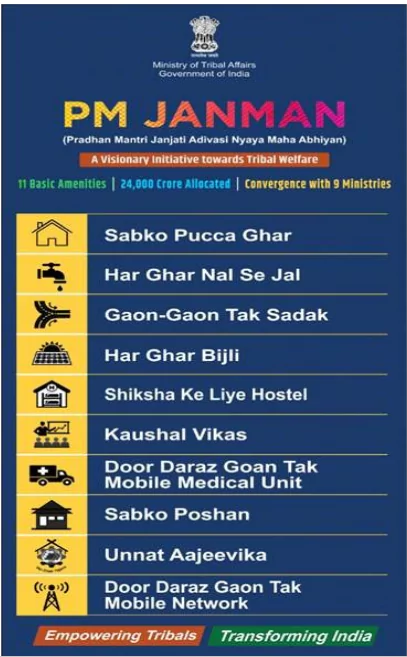Recently, Prime Minister Narendra Modi is set to launch a commemorative Stamp and coin to mark the 150th birth anniversary of tribal icon and freedom fighter Birsa Munda at an event scheduled in Jamui district of Bihar.
- The PM will also participate in the virtual “Griha Pravesh” of about 11,000 homes that have been constructed under the PM-JANMAN package and launch about 50 mobile medical units under the above-mentioned schemes.
Enroll now for UPSC Online Classes
About Birsa Munda
Early Life and Background
- Birth: He was born in 1875 in the village of Ulihatu, in the Mundari princely state of Khunti, and grew up in a time when the Munda people were facing increasing exploitation and displacement by British colonial rule and Hindu landlords.
- His birth anniversary falls on 15th November, which is celebrated as ‘Birsa Munda Jayanti’.
- A Munda Leader: Birsa Munda was a tribal leader and religious reformer who belonged to the Munda tribe of Chotanagpur, a region in present-day Jharkhand and Odisha.
- Founded the faith of Birsait: Blend of animism and indigenous beliefs which emphasised the worship of a single god.
- Given the nickname ‘Dharti Aba’ or the father of the earth.
- Legacy:
- State of Jharkhand was created on his birth anniversary in 2000
- The birth anniversary of Birsa Munda was declared ‘Janjatiya Gaurav Divas’ by the Central Government in 2021.
Significant Movements
- Mundaism: In the late 19th century, Birsa Munda founded a new religious movement known as “Mundaism” or “Kisangism”.
- Aim: To revive traditional Munda customs and beliefs and unite the Munda people against their oppressors.
- Emphasis On: Birsa’s teachings emphasized the importance of self-reliance, social justice, and resistance against oppression.
- Preachings: He preached that the Munda people should return to their traditional values and reject the influence of both British colonialism, missionaries.
- The Great Tumult Movement: Birsa’s movement, the Ulgulan or Great Tumult, arose in the Chotanagpur region of the Bengal Presidency (now Jharkhand).
- It mobilized Munda and Oraon tribals against forced labor, missionary activities, and colonial land appropriation.
- Death: The British arrested Birsa in 1895 and he died in prison in 1900.
- His death sparked violent protests and he became a martyr for tribal activism against the British.
- The impact of the Munda revolt was the establishment of the Chotanagpur Tenancy Act in 1908.
- It restricted the transfer of tribal land to non-tribal owners, and recognized the tribal community’s customary rights to land, water, and forest.
- The act also introduced the “Mundari Khuntkattidar” tenure category, which recognized the original settlers of the land among the Mundas.
About PM-JANMAN

- Launched by Prime Minister Narendra Modi in November, 2023, in Khunti District, Jharkhand.
- Aims to reach 22,000 Particularly Vulnerable Tribal Groups (PVTG) in 200 districts across the country.
- Initial phase targets 100 districts covering 500 blocks and 15,000 PVTG habitations across 18 states and the Union Territory of Andaman and Nicobar Islands.
- India has 10.45 crore Scheduled Tribe (ST) population, with 75 communities identified as PVTGs across 18 states and the Union Territory of Andaman and Nicobar Islands.
- Campaign Objectives and Scope:
- Objective: Saturate PVTG families with individual entitlements and provide basic facilities to habitations by raising awareness about their entitlements.
- Providing Aadhar cards, community certificates, and Jan Dhan accounts as basic requirements for accessing other schemes.
- Targeting unreached PVTG households due to distance, lack of road connectivity, and digital access.
- Utilizing various locations like Haat Bazar, CSC, Gram Panchayat, etc., to reach PVTG communities.
Check Out UPSC NCERT Textbooks From PW Store
Particularly Vulnerable Tribal Groups (PVTG)
- Defined as the most vulnerable among tribal groups in India.
- Characteristics include primitive traits, geographical isolation, low literacy, negative population growth, reliance on hunting, and pre-agriculture level technology.
- Dependent on Non-Timber Forest Produce (NTFP) for sustenance and often suffer from various diseases due to their diet.
Origin and Status:
- In 1973, the Dhebar Commission established a separate category for Primitive Tribal Groups (PTGs).
- In 1975, 52 tribal groups were identified as PTGs; later, 23 more groups were added in 1993, eventually named PVTGs in 2006.
- Approximately 2.8 million PVTGs belong to 75 tribes across 18 states and Union Territories.
- States with significant PVTG populations: Odisha, Madhya Pradesh, Andhra Pradesh (including Telangana).
- Odisha’s Saura community is the largest PVTG, numbering 535,000.
- No PVTG found in Punjab and Haryana.
Criteria for Identification
- Pre-agricultural level of technology
- Low level of literacy
- Economic backwardness
- A declining or stagnant population.
|
![]() 15 Nov 2024
15 Nov 2024


